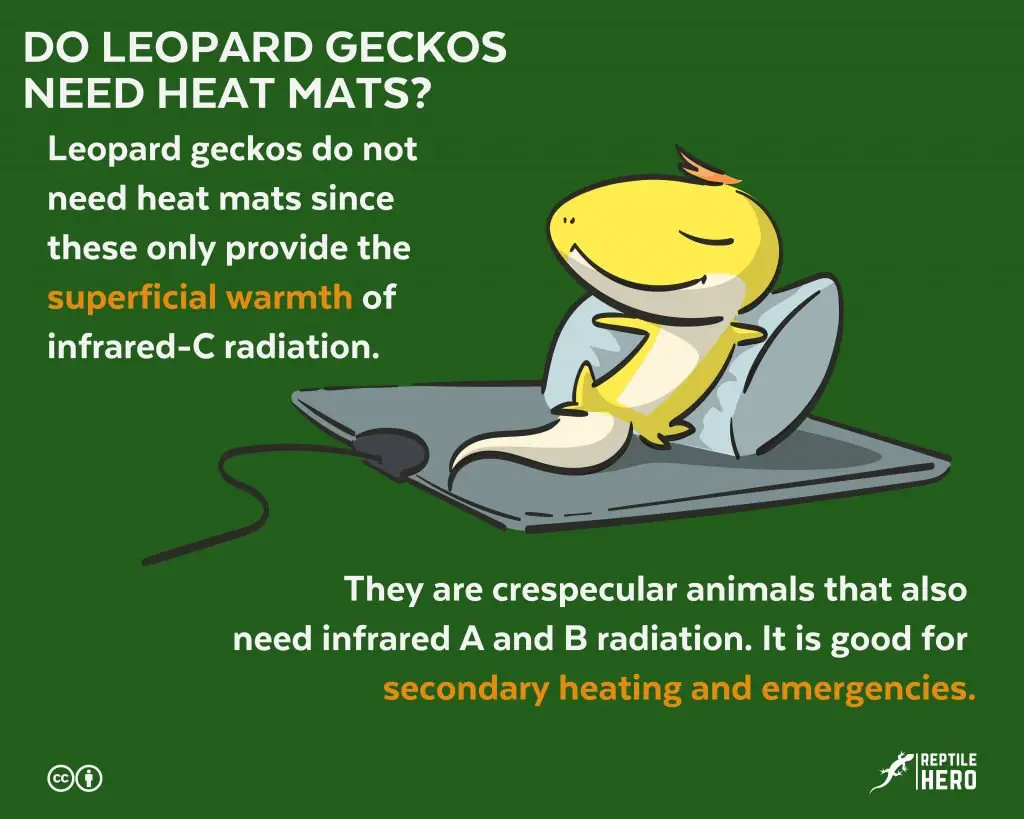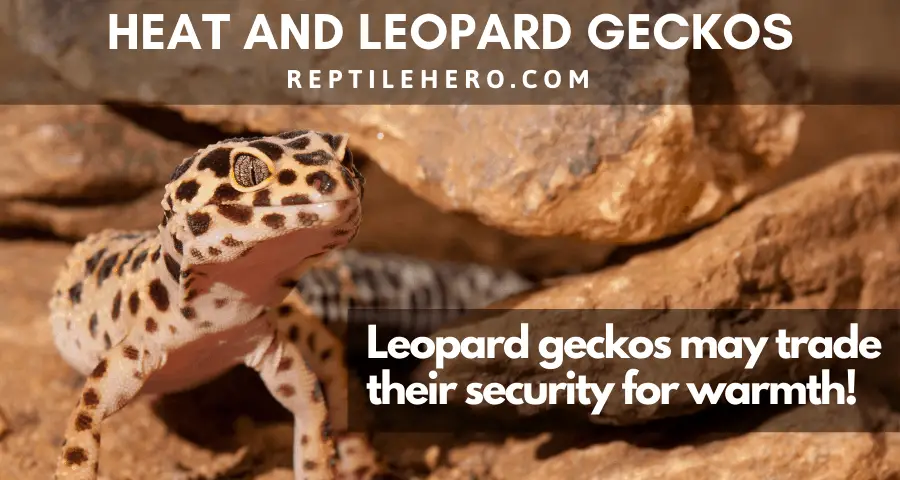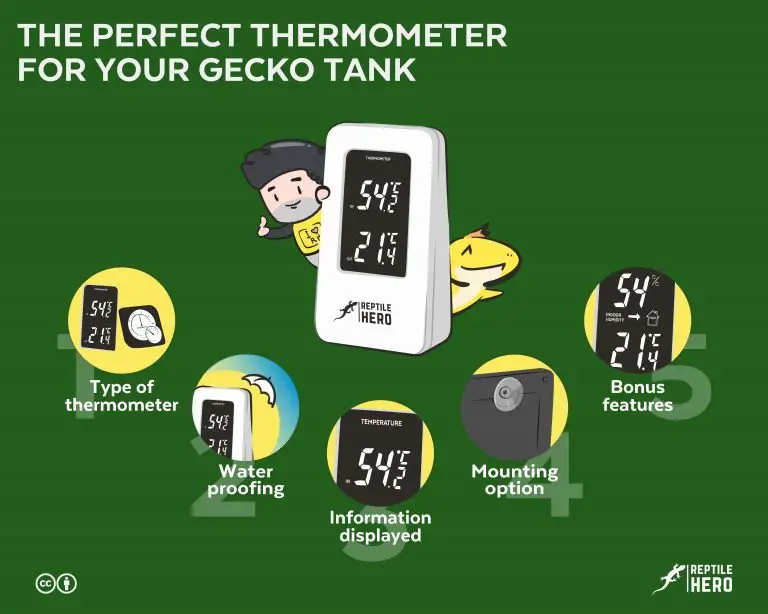Do Leopard Geckos Need Heat Mats? [Myth or Truth]
Belly heat and heat mats: these two ideas used to be accepted by most gecko keepers and breeders as the gold standard for keeping our adorable little leos warm and cozy. However, with the recent increasing push towards the use of overhead heating, is there any truth to our old ways?
As a whole, leopard geckos do not need heat mats since these only provide the superficial warmth of infrared-C radiation. They are crepuscular animals that also need infrared A and B radiation. While it should never be used as the only heat source, it is good for secondary heating and emergencies.
Continue reading to learn how to properly heat things up for your leopard gecko!

Heat and Leopard Geckos: 101
Whether you are a new gecko dad or mom or you have been part of the reptile community for years now, I am pretty sure you have heard of leopard geckos needing belly heat at least once. In fact, I know a couple of people who still use heat mats to provide their leos with belly heat to this day. So what exactly does science have to say about this husbandry practice?
Leopard geckos have mostly been recognized as thigmothermic ectotherms, meaning they absorb heat mainly by having direct skin contact with organic materials such as rocks and substrates that have warmed up from sun exposure. However, there is evidence that they also engage in heliothermic behavior – basking.
To better understand what all this means, you need to be familiar with the following terms:
- Cold-bloodedness
- Thermoregulation
- Belly heat
Cold-bloodedness
As you probably know by now, leopard geckos are considered cold-blooded animals. Well, to be more precise and correct, leopard geckos and many other reptiles are ectotherms. They are unable to produce their own body heat and, therefore, rely on their surroundings for both warmth and coolness. Thus, environmental heat is crucial for a leopard gecko’s activity and digestion among many other things.
Thermoregulation
Thermoregulation is the term used to refer to the activities (e.g., burrowing, staying in a crevice, etc.) our soft-scaled babies engage in to maintain their preferred and optimal body temperature. But not many are aware that there are two more specific techniques of ectothermal thermoregulation [1].
1) heliothermy: A heliothermic animal will stay in a completely open or slightly covered space to receive direct sunlight and heat. This behavior is otherwise called basking, believed to be only done by diurnal species.
2) thigmothermy .a nocturnal thigmothermic animal conducts heat from the ground which has been heated up by the sun during the day.
Belly Heat
Much like the term cold-blooded, the term “belly heat” used in connection with thigmothermy has created misconceptions within the community. Furthermore, because leopard geckos were previously thought of and classified as strictly nocturnal species, some pet parents still mistakenly believe that leopard geckos are only capable of absorbing heat from their bellies or ventral side.

In truth, leopard geckos are crepuscular creatures. They go out of hiding during dusk and dawn to forage for food and warm up their small bodies. This means they also get direct sun exposure. Moreover, there have been reports of them staying out in the open for sufficient heat made by both pet owners and scientists regardless of whether hides are available or not [2]. So it seems that in captivity, heat is more important to them than shelter. Just note that much research is still needed to confirm this belief.
What is a Heat Mat and How Does It Work?
Heat mats are one of the most well-known heating devices used in the reptile-keeping community. These are thin pliable panels made with conductive metal sheets or strips encased in a plastic material.
Under tank heaters (UTH), and heat mat, pads, or panels all refer to the same device still quite commonly used by a great handful of reptile keepers. They were created with the idea of mimicking the residual heat radiated by trees, rocks, soil, and other natural materials after being subjected to direct sunlight during the day.
Guess what? Sunlight isn’t only made of visible light and ultraviolet (UV) light [3]. As a matter of fact, sunlight also emits infrared (IR) waves which, like UV, are invisible to the human eye. Though infrared radiation can’t be seen, it surely can be felt as heat. Similar to UV, there are 3 different types of infrared: infrared A (IR-A), infrared B (IR-B), and infrared C (IR-C). The two main difference among them being their wavelength and penetrative capability.
Below is a short illustrative video to help you visualize how infrared radiation in sunlight heats up the Earth. You can skip to the 1:10 minute mark or watch it from start to finish:
Heat mats are not suitable to be used as a primary heating source for leopard geckos because it does not significantly affect overall air temperatures. This product only radiates heat onto the flooring, gecko or reptile’s underside, and other enclosure furnishings placed in close proximity to it. It does not significantly raise the overall ambient temperature.
The type of thermal radiation heat pads or mats produce is only long-wave infrared radiation – also known as far-infrared (FIR) or IR-C. Although it does mimic the heat the ground gives off thanks to the sun, it does not mimic to overall natural heat leopard geckos get in the wild. IR-C only penetrates the skin, it cannot substantially warm your gecko and help him or her obtain and maintain an optimal core (inner-body) temperature.
Normally, UTHs are placed outside, right below the base of the tank as the name implies. However, for wooden vivariums like this one from Zen Habitats, it must be placed inside the vivarium as wood is generally a great heat insulator. With such a placement though, only the bottom of the vivarium gets heated.
Despite also having the option to mount it on the enclosure wall, because it does not radiate deep-penetrating heat, your gecko will not be able to thermoregulate properly as only one wall and a few decors become warm enough. This will be quite obvious as your soft-bellied leo would most likely only stay right by the side where the heat pad is wall-mounted, barely moving around the tank.
2 Special Cases When Heat Mats Should be Used In Leopard Gecko Enclosure
Considering how under-tank heaters only provide superficial warmth, you will be surprised to find out that many hobbyists still use this heating device. However, there are three distinctly different reasons as to why gecko keepers can use heat mats: 1) supplemental heating, and 2) emergency or temporary use.
#2 – Supplemental Heating
Heat mats are a good choice for secondary heating devices in enclosures bigger and taller than 50-gallon tanks that already have an overhead fixture that serves as the primary heat source during the morning and/or night.
When using large enclosures for single leopard geckos as well as long-term breeding pairs, sufficient heating can be challenging to achieve. In these instances, having a supplemental heating source would be necessary.
Plus, heat mats are one of the cheapest and easiest heating elements to install. Additional fittings such as stands, clamps, and cages are not needed. Moreover, since they do not emit visible light, they can be turned on during the night as well. Lastly, unlike lamps, these do not need to be replaced regularly.
But then again, being able to save on money doesn’t always equate to being able to give your leopard gecko the best tank and living conditions.
#2 – Emergency or Temporary Use
Compared to other heating devices such as ceramic heat emitters, deep heat projectors, and halogen lamps, heating pads usually only have a power rating of up to 60W. In case of an outage where only a small power bank might be available, heat pads make it possible to provide geckos a constant and stable heat source for a much longer time compared to powering a fully equipped set-up.
For times of emergency such as a winter power outage, you could opt to use an old UTH plugged into a power bank to keep your gecko warm enough until the electricity grid is up and running again – no frozen geckos.
Traveling long distances by car with your gecko will also be possible even in the coldest of days – or nights – with the help of a good little meat mat and a reliable portable power station.
If you need to quarantine a new or sick gecko, having a small plastic enclosure with minimal decor and paper towel sheets for substrate would be needed. But as most people know, temporary plastic tanks may warp and melt when used with a high-powered overhead heater. Here, using a heating pad is preferable and considered safer.
Other than that, dysecdysis or retained skin can be effectively treated by creating a humidity chamber or sauna for your leopard gecko [4]. To do this, you can use an old but clean 10-gallon aquarium with a damp towel at the bottom, as well as a heating mat – like this one on Amazon – below.
The top should not be sealed up completely to allow for ample ventilation and avoid suffocation. Instead, loosely cover the top with a thin, breathable piece of cloth to increase humidity levels while also allowing for airflow.
Why Do Leopard Gecko Owners Keep Using Heat Mats?
Due to such misinformed beliefs, owners and breeders thought that providing leopard geckos with belly heat using UTHs is the best way to keep them warm. This outdated practice of only providing heat mats for primary heating still persists to this day.
As previously stated, leopard geckos were once incorrectly thought to be only capable of receiving heat by the ventral portion of their bodies. This myth can be attributed to the misinterpretation of the term thigmothermy. In addition to this, leopard geckos are known to be terrestrial in nature.
So if you know someone with such a set-up, please do kindly inform them that though they have good intentions for doing so, it just can’t provide adequate warmth for their beloved gecko.
Keep in mind as well that in spite of the fact that these animals are mostly on all fours either on or beneath the ground, they also climb rock outcroppings and hollow tree trunks in the wild even though they don’t have sticky feet. So having a heating device that will produce not only great floor heating but ample ambient temperatures is key to having a healthy and active gecko.
This experienced pet owner will testify for me on observable behavioral changes of leopard geckos upon switching to overhead heating from under tank heating:
Final Verdict on Heat Mats for Leopard Geckos
Reptile heat mats are not the most efficient heating element you can provide for your leopard gecko. However, they are neither bad nor useless as they can still be used as a secondary heat source and for emergency or temporary housing.
If it wasn’t obvious yet, I do not recommend the use of heating mats for your precious pet’s sole heater. Like the sun, the perfect primary heating element should be placed above the tank and produce IR-A and IR-B radiation as well.
Of course, unless you want to avoid having your gecko freeze to death in the event of a prolonged blackout in the middle of a snowstorm, you can use a heat mat for the time being. So the next time you see a heat mat don’t brush it off as a waste of money. But don’t claim that it is the best way to keep your reptiles happy and healthy either.
How to Safely Set Up and Use Heat Mat

To ensure that your leopard gecko will have a sufficient thermal gradient inside the tank for proper thermoregulation, the heat mat should cover 1/2 or 1/3 of the vivarium’s total floor space and must be placed on the warm side.
When used with a primary heat source (e.g., halogen lamp) the enclosure should have an ambient temperature in the cool side of 70-80°F (21-27°C) and warm side of 85-90°F (29-32°C), as well as a basking spot of 95-100°F (35-38°C) [5].
Here are 4 general steps in setting up a heat mat for your leopard gecko:
- Double-check. Read the product label and installation guide to ensure that it is compatible with your vivariums’ material (i.e., plastic, glass, wood).
- Assess the quality. Inspect the product for damage (e.g., cuts, protruding wires, etc.) before turning it on for any test runs.
- Regulate the heat. Connect it to a thermostat like this one on Amazon and place the probe near the meat mat; above if placed below or beside if placed on the wall.
- Test it out. Once you have your vivarium set-up complete, place it as needed (e.g., inside, outside, below, beside) and observe it for at least 2 whole days (24 hours) before letting your gecko inside.
A variety of heat mats produced by different companies are available in the market. Some come with an adhesive side for easier and direct mounting on the side or bottom of your glass or plastic vivarium.
There have been cases of glass vivariums cracking and plastic vivariums warping from intense unregulated heat of adhesive heat mats. So non-adhesive units like this one on Amazon are preferred by some leopard gecko keepers.
Others are non-adhesive and usually come with rubber footings to prop your tank up, they should be placed right below glass and plastic enclosures. Non-adhesive heating pads can also be placed inside a wood enclosure, below a thin layer of substrate (approximately 0.39 in or 1 cm).
Regardless, a heat mat must never be in direct contact with your leopard gecko’s skin to prevent thermal burns. It should also get some ventilation to avoid overheating and possible fires.
Takeaways
Heat mats can be used as supplemental and/or emergency heat sources but should never be used as a leopard geckos only heat source. It only produces IR-C radiation which is not a penetrating thermal heat.
An overhead heat source that imitates the warmth of the sun thru direct exposure during the day and conduction during the night should be used for a leopard gecko’s primary heat source instead of a heat mat.
Possible hazards of using heat mats improperly include thermal burns, overheating, fire, and tank damage.
Sources
[1] https://academic.oup.com/biohorizons/article/1/2/136/269082
[2] https://pubmed.ncbi.nlm.nih.gov/28635030/
[3] https://en.wikipedia.org/wiki/Sunlight
[4] https://www.msdvetmanual.com/all-other-pets/reptiles/disorders-and-diseases-of-reptiles
[5] https://arborviewah.com/wp-content/uploads/2021/03/Leopard-Gecko-PDF.pdf

![What Do Dwarf Geckos Eat? [With Examples + 6 Things To Remember]](https://www.reptilehero.com/wp-content/uploads/2021/12/dwarf-gecko-eats-cc-768x614.jpg)

![The 8 Differences Between A Newt And A Leopard Gecko [+ Fun Fact!]](https://www.reptilehero.com/wp-content/uploads/2021/04/Newt-vs-Gecko-Infographics-768x614.jpg)


![6 Reasons Why Geckos Make a Clicking Sound [With Science]](https://www.reptilehero.com/wp-content/uploads/2021/01/Gecko-Vocalization-768x576.png)
